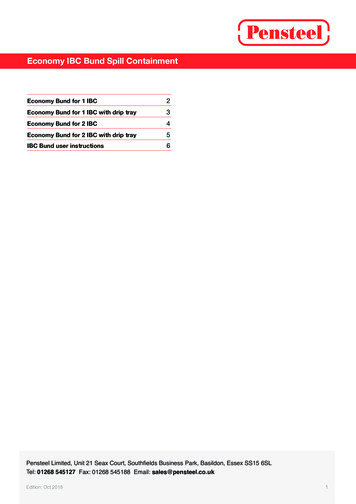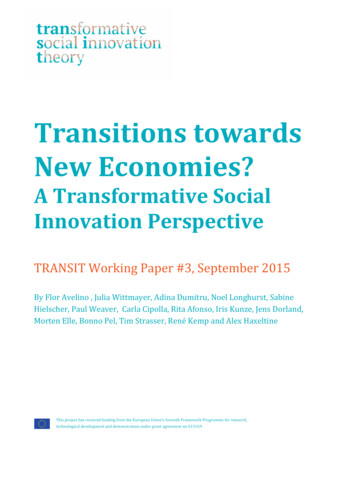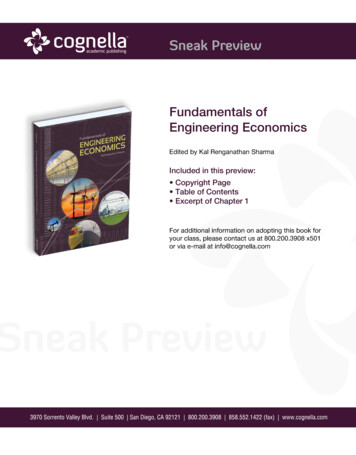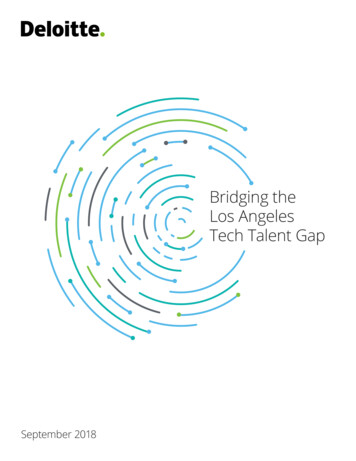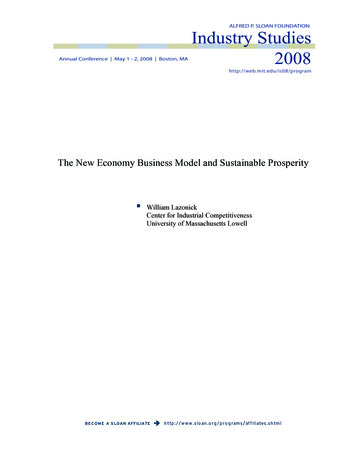
Transcription
The New Economy Business Model and Sustainable Prosperity William LazonickCenter for Industrial CompetitivenessUniversity of Massachusetts LowellBE C OME A S LOAN AFFILIATE h ttp :/ / www.slo an .o rg / p ro g rams / affiliates.sh tml
The New Economy Business Modeland Sustainable ProsperityWilliam LazonickCenter for Industrial CompetitivenessUniversity of Massachusetts LowellRevised March 25, 2008Paper to be presented at the Alfred P. Sloan Annual Industry Studies Conference, ParkPlaza Hotel, Boston, May 1, 2008. A previous version of this paper was presented at the3rd International CLPE Workshop on “The Embedded Firm”, Osgoode Hall Law School,York University, Toronto, March 20-21, 2008. This material in this paper is drawn frommy forthcoming book, Sustainable Prosperity in the New Economy?: BusinessOrganization and High-Tech Employment in the United States, the research for whichwas funded by The W. E. Upjohn Institute for Employment Research. Additional fundingwas provided by the ESEMK project of the European Commission under the 6thFramework Programme (contract CIT2-CT-2004-506077).
Lazonick: The New Economy Business Model and Sustainable ProsperityThe Rise of the New Economy Business ModelThe Internet boom of the last half of the 1990s seemed to herald the arrival of a “NewEconomy” with its promise that, after the stagnation of the early 1990s, innovation ininformation and communication technologies (ICT) would regenerate economicprosperity. The subsequent collapse of the Internet boom at the beginning of the 2000scalled into question the New Economy’s ability to deliver on this promise – and evenraised questions about whether there had really been anything “new” about the economyof the late 1990s after all. Perhaps the journalist John Cassidy (2002) was correct toentitle his well-documented book on the Internet boom “dot.con: the greatest story eversold”. If the “New Economy” was just all smoke and mirrors, one would expect that,once the debris left behind by the storm of speculation and corruption had been clearedaway, economic life would return to what it had been before the boom took place.It is now clear that there was plenty of e-con in the New Economy. At the same time,however, there was something new, important, and permanent about the New Economythat transformed the economic lives of many from those they had led before. The core ofthat something new, important, and permanent is what I call the “New Economy businessmodel” (NEBM), a mode of organizing business enterprises that has changed, perhapsdramatically, the ways in which, and terms on which, people in the United States areemployed.NEBM emanated from Silicon Valley and spread to other regions of the United States.NEBM also affected employment relations in other areas of the world, especially Europeand Asia, as US-based ICT companies extended their global reach and as high-techcompanies based outside the United States sought to adopt elements of the new businessmodel. With well-educated high-tech labor flowing into the United States from abroad,especially from India and China, and with US-based ICT companies offshoring varioustypes of business activities to other countries, again especially to India and China, theICT labor force had become by the 2000s vastly more globalized than it had been prior tothe Internet revolution.While the Internet boom of the late 1990s made the “New Economy” a household phrase,the end of the boom did not result in the demise of NEBM. To the contrary, itscharacteristic features have become more widespread and entrenched in the US ICTindustries in the 2000s. With its startup firms, vertical specialists, venture capital, andhighly mobile labor, NEBM is a business model that remains dominant in the UnitedStates, and it is one that many national policy-makers and corporate executives aroundthe world seek to emulate. At the same time, within the United States, it is a businessmodel that has been associated with volatile stock markets, unequal incomes, andunstable employment, including the insecurity associated with the offshoring of high-skillICT jobs. If we define “sustainable prosperity” as a state of economic affairs in whichgrowth results in stable employment and an equitable distribution of income, then theprosperity of the US economy would appear to be unsustainable. There is a need tounderstand the organizational and industrial dynamics of NEBM if only to determine how1
Lazonick: The New Economy Business Model and Sustainable Prosperitythe tapping of its innovative capability might be rendered compatible with more sociallydesirable outcomes.The “Old Economy business model” (OEBM) that dominated the US corporate economyin the decades after World War II and into the 1980s offered employment that was farmore stable and earnings that were far more equitable than employment and earnings inthe era of NEBM. The sociological foundation of OEBM was the “organization man”.Popularized in the United States in the 1950s (Whyte 1956), the stereotypical“organization man” was a White, Anglo-Saxon, Protestant male who had obtained acollege education right after high school, secured a well-paying job with an establishedcompany early in his career, and then worked his way up and around the corporatehierarchy over three or four decades of employment, with a substantial “defined benefit”pension, complemented by highly subsidized medical coverage, awaiting him onretirement. 1 The employment stability offered by an established corporation was highlyvalued, while interfirm labor mobility was shunned.The “organization man” could trace his origins back to the early decades of the 20thcentury, and in the immediate post-World War II decades he was ubiquitous in the officesof the US corporate enterprises that were the dominant employers in the US economy.Somewhat ironically, when in the 1980s formidable Japanese competitors confronted USbased Old Economy companies, many US observers of Japan’s “lifetime employment”system viewed it as a mode of organization that was quite alien to the American way oflife. In the post-World War II decades US business corporations had their own versionsof lifetime employment, complete with what the Japanese call “salarymen”. UScorporations had over the course of the 20th century transformed the salaried professional,technical, and administrative employees who peopled the managerial structure intoorganization men. By the 1950s and 1960s, moreover, even unionized productionworkers, ostensibly paid on an “hourly” rather than salaried basis, found that collectivebargaining protected their positions of seniority, so that they too experienced, and in agrowing economy came to expect, lifetime employment as well as defined-benefitpensions and comprehensive health benefits, just like the salaried managers of thecompanies for which they worked.From this historical perspective, NEBM can best be described as “the end of organizationman”. It is not that New Economy companies have ceased to build complex and durableorganizations. To attain and sustain competitive advantage, companies such as Intel,Microsoft, and Cisco – the gold-plated enterprises of the New Economy -- need tointegrate the labor services of tens of thousands of individuals who participate in complexhierarchical and functional divisions of labor. In an innovative enterprise, the role of anintegrated division of labor is to develop and utilize new technologies. Indeed, one might1In the early 1950s the sociologist C. Wright Mills (1951) had written an influential academic treatise onthe significance of the “white collar” employee. William H. Whyte (1956), who wrote his best-sellingThe Organization Man while an editor of Fortune, later became a prominent urban sociologist. It is alsoworth noting that John Kenneth Galbraith (1967), an agricultural economist by training, gained many ofhis insights into what he eventually called the “technostructure” of The New Industrial State while aneditor of Fortune in the late 1940s.2
Lazonick: The New Economy Business Model and Sustainable Prosperityargue that, given heightened technological complexity and intensified market competitionin the “open systems” world of ICT, the building of unique organizational capabilities hasbecome more, not less, critical to the success of the enterprise than before.Nor is it necessarily the case that employees who spend their entire careers with onecompany have become an endangered species. The leading industrial corporations stillhave low levels of employee turnover. Rather what is new is the lack of a commitment.,explicit or implicit, on the part of US high-tech companies to provide their employeeswith stable employment, skill formation, and rewarding careers. When an employeebegins to work for a company in the New Economy, he or she has no expectation of acareer with that particular enterprise. Nor does a person with ICT capabilities necessarilywant to work for one company for years and decades on end. Interfirm labor mobilitycan bring benefits to an employee, including working for a smaller company, choice ofgeographical location in which to work, a step increase in salary, access to employeestock options as a potential source of income in addition to a salary, and new learningexperiences. The New Economy business model represents dramatically diminishedorganizational commitment on both sides of the employment relation compared with itsOld Economy predecessor.A corollary of this diminution in organizational commitment in NEBM has been anincreased globalization of the types of labor that US-based ICT firms employ. Thisglobalization of labor has occurred through the offshoring of high-tech work and theinternational mobility of high-tech labor, neither of which is a new phenomenon but bothof which have intensified over the past decade or so. The employment relations of majorUS-based ICT companies have become thoroughly globalized, based on corporatestrategies that benefit from not only lower wages but also the enhancement of ICT skilllevels in non-US locations, especially in Asia and increasingly in Eastern Europe.While the extent of these impacts of NEBM on ICT employment has become evidentonly since the last half of the 1990s, NEBM itself has taken a half-century to unfold.Indeed, its origins can be found in the mid-1950s at precisely the time when the OldEconomy industrial corporation was at the pinnacle of its power. NEBM evolved as anintegral element of the microelectronics revolution. The development of computer chipsfrom the late 1950s provided the technological foundation for the microcomputerrevolution from the late 1970s, which in turn created the technological infrastructure forthe commercialization of the Internet in the 1990s. While the US government and theresearch laboratories of established Old Economy corporations played major, and indeedindispensable, roles in supporting these developments, each wave of innovation generatedopportunities for the emergence of startup companies that were to become central to thecommercialization of the new technologies.The regional concentration of these new ventures in what would become known asSilicon Valley reinforced the emergence of a distinctive business model. From the late1960s venture capitalists backed so many high-tech startups in the vicinity of StanfordUniversity that they created a whole new industry for fostering the growth of youngtechnology firms. These startups lured “talent” from established companies by offering3
Lazonick: The New Economy Business Model and Sustainable Prosperitythem compensation in the form of stock options, typically as a partial substitute forsalaries, with the potential payoff being the high market value of the stock after an initialpublic offering or the private sale of the young firm to an established corporation. Asthese young companies grew, annual grants of stock options to a broad base of potentiallyhighly mobile people became an important tool for retaining existing employees as wellas attracting new ones. The subsequent growth of these companies occurred, moreover,not only by investing more capital in new facilities and hiring more people but also byacquiring even newer high-tech companies, almost invariably using their own stockrather than cash as the acquisition currency. In addition, wherever and wheneverpossible, ICT companies that, as systems integrators, designed, tested, and marketed finalproducts outsourced manufacturing of components so that they could focus on highervalue-added work. This outsourcing strategy became both more economical and moreefficient over time as contract manufacturers developed their capabilities, includingglobal organizations and highly automated production processes, for a larger extent of themarket.These features of the new ICT business model were already evident to industry observersin the late 1980s. It was only in the Internet boom of the last half of the 1990s, however,that this ICT business model had a sufficient impact on product market competition andresource allocation, including interfirm labor mobility, as well as productivity to givepopular definition to a “New Economy”. In my book, Sustainable Prosperity in the NewEconomy?, I document the evolution of NEBM over the past half century as a foundationfor understanding the origins of the globalization of ICT employment in the 2000s, andits current implications for ICT employment opportunities in the United States.My central argument is that NEBM has definitively replaced OEBM as the dominantmode of business organization in the ICT industries of the United States. NEBM hasbeen, and continues to be, an important engine of innovation in the US economy, andhence an important source of economic growth. The performance of an economy,however, is not measured by growth alone. Economists give high marks to an economythat not only generates growth but does so in a way that provides stable employment andan equitable income distribution -- what I call “sustainable prosperity”. Yet over the pastdecade or so, NEBM has been an engine of innovation that has contributed to instabilityand inequity. ICT continues to help make the United States the richest economy in theworld, in terms of both absolute and per capita income. The increased dominance ofNEBM in the organization of the ICT industries, however, has meant increasinglyinsecure employment and incomes for most workers in the US ICT industries, and hasbecome an important factor in the trend toward greater employment instability andincome inequality in the US economy as a whole.Following the Internet boom and bust, what is particularly novel about the employmentsituation of the 2000s thus far has been the extent to which the most highly educatedmembers of the US ICT labor force have experienced this insecurity as many of the wellpaid jobs that they used to hold have been offshored. In terms of their education andqualifications, these are the people who in another era would have been the prototypicalorganization men, although they are no longer so uniformly White, Anglo-Saxon,4
Lazonick: The New Economy Business Model and Sustainable ProsperityProtestant or male, as the organization men of the 1950s were apt to be. The publicoutcry against the “export of American jobs” in this first decade of the twenty-firstcentury in effect laments the demise of organization man.For whom does America compete?Driven by the microelectronics revolution, the United States has been highly innovativeeconomy over the past three decades. The resultant economic growth, however, has beenunstable, while the distribution of income in the US economy has become significantlymore unequal. In my forthcoming book, Sustainable Prosperity in the New Economy?, Ishow that the transition from OEBM to NEBM in the ICT industries has contributed tothis instability and inequity. Gone is the collective security that the corporatist OldEconomy business model once offered its employees. In its place is a far moreindividualized relation between employer and employee. The employment and incomesof even the most highly educated members of the US labor force are now much moresusceptible to the pressures and vagaries of “market forces” than they were a few decadesago. In particular, global labor markets and national financial markets now exertpreponderant influences on the conditions of high-tech employment in the United States.In the regulation of the employment relation, “market forces” are not a natural state ofaffairs. Rather the policies and decisions of corporations and governments shape howand in whose interests capital and labor markets function (Lazonick 1991 and 2003).Since the late 1970s in the United States corporate strategies and government policieshave combined to define the ways in which NEBM allocates resources, employs labor,and finances investments.When US corporate executives systematically allocate billions of dollars to stockrepurchases, they will argue that the stock market requires them to do so. Yet in the2000s the powerful corporations that have the financial resources to engage in thispractice are actually using their financial might to manipulate the stock market -- to thedirect benefit of those executives who make resource-allocation decisions. When UScorporate executives systematically offshore as much productive activity as possible tolower-wage regions of the world, they will argue that the forces of market competitioncompel them to do so. Yet in making these decisions they are generally unaccountable tocurrent US-based employees who have helped to build the organizations that are capableof globalization, and they rarely consult with these employees about alternative strategiesfor maintaining and extending the competitiveness of the company. Armed with theideology of “maximizing shareholder value”, US corporate executives who control theallocation of their companies’ resources now simply take it as a fundamental, and selfserving, assumption that they are responsible to shareholders alone.The US federal government has played a significant role in aiding and abetting the modesof resource allocation that prevail under NEBM. It continues to devote tax revenues tofund the nation’s high-tech knowledge base, but demands little if any accountability fromso-called “private” enterprises about how or for whose benefit this knowledge base isused. If the top executives of US corporations that have benefited from government5
Lazonick: The New Economy Business Model and Sustainable Prosperitylargesse in the past now say they have to offshore to remain competitive, then the USgovernment will not stand in the way or demand a quid pro quo. Through itsimmigration legislation, the US government has accommodated, until recently at least,the demands of the high-tech lobby for more non-immigrant work visas, while providinglittle in the way of effective oversight over the use, and abuse, of these visas. Through itstax policies, for the past three decades, the US government has basically taken theapproach that whatever those who exercise strategic control over the allocation ofcorporate resources say they need to be competitive is what they need to get. In failing tointervene to regulate the remuneration of corporate executives, the US government hasbeen a party to the apparently never-ending explosion in top executive pay that theUnited States has witnessed over the past three decades.US corporate executives claim that they have a fiduciary responsibility to maximizeshareholder value. Yet, as I have shown elsewhere (Lazonick and O’Sullivan 2000;Lazonick 2007c), it is a perspective that fails to address the conditions under whichbusiness enterprises are in fact innovative. In particular, the ideology of “maximizingshareholder value” ignores the role of workers, communities, and governments in makinginvestments in the innovation process without any guarantee of a return. Indeed, even ascorporate executives spout this ideology, and enrich themselves in the process, they arefar from shy in appealing to the US government for increased spending on knowledgecreation and lower burdens of taxation in order to keep the “United States” competitive.As a prime example, on March 16, 2005 the Semiconductor Industry Association (SIA),accompanied by Dale Jorgenson, a neoclassical Harvard economist, organized aWashington, DC press conference in which it exhorted the US government to step upsupport for research in the physical sciences, including nanotechnology, to assure thecontinued technological leadership of the United States. Intel CEO Craig Barrett wasthere as a SIA spokesperson to warn that “U.S. leadership in technology is underassault.” 2The challenge we face is global in nature and broader in scope than any we havefaced in the past. The initial step in responding to this challenge is that Americamust decide to compete. If we don’t compete and win, there will be very seriousconsequences for our standard of living and national security in the future .U.S.leadership in the nanoelectronics era is not guaranteed. It will take a massive,coordinated U.S. research effort involving academia, industry, and state andfederal governments to ensure that America continues to be the world leader ininformation technology.Why, one might ask, should America “decide to compete” in ICT if a powerful companylike Intel will be able to commercialize the new technologies that emerge from such “amassive, coordinated U.S. research effort” without any consideration of the extent towhich Americans will benefit? Barrett is also on record as saying: “Companies like Intelcan do perfectly well in the global marketplace without hiring a single US employee.” 3To echo a question that former US Labor Secretary Robert Reich (1990) in a well-known23“US could lose race for nanotech leadership, SIA panel says,” Electronic News, March 16, 2005.Craig Barrett, Interviewed by Tom Ashbrook, On Point, WBUR, February 11, 2006.6
Lazonick: The New Economy Business Model and Sustainable ProsperityHarvard Business Review article in 1990, written before the transition to NEBM hadbecome apparent: “Who is Us”? 4In a world of global competition, a nation does need innovation to generate economicgrowth. When, however, corporate executives use stock-based compensation to skew thedistribution of income in their favor, and when they decide to terminate the employmentof qualified people even as the company is reaping the returns on its past investments ininnovation in which these very people participated, then it may well be that many UScitizens will lose even as the companies for which they work, or used to work, remainprofitable. In the New Economy, “competitiveness” is, like “shareholder value”, a highlyloaded ideological term. To quote Harris Miller, from 1995 to 2006 president of theInformation Technology Association of America, when he was a key lobbyist for theImmigration Act of 1990: “We were successful because we refashioned the debate fromthe jobs displacement issue, where we always lost, to the competitive issue” (Lee 1991).Earning a living in the United States has never been easy for those who are poorlyeducated and lack work experience. In the 2000s, however, even well-educatedAmericans with substantial work experience face far greater employment insecurity thanthey did in the past. In documenting the instability and inequity inherent in NEBM, I amnot advocating a return to OEBM. There is a need, however, to recognize the collectivefunctions that OEBM performed in providing security in employment and retirement to asignificant proportion of the US labor force. The fact that, in the Old Economy, USbusiness corporations performed these functions greatly reduced the need for thegovernment to be directly involved in ensuring stable and equitable growth. I wouldeven argue that because by the 1960s business corporations performed these collectivefunctions for such a substantial portion of the population, the US government couldcontemplate launching a “War on Poverty” to upgrade the employment prospects of thosesegments of the US population for whom business corporations did not provideemployment security. In a variety of ways, OEBM provided a foundation, including aconsensus among an economic elite, for the government to intervene in the economy todeal with problems of instability and inequity. With the decline of OEBM, and itsreplacement by NEBM, from where will such a new consensus come?An era of more stable and more equitable economic growthAn understanding of the historical context in which OEBM performed these collectivefunctions in the post-World War II decades is critical for analyzing both the power ofOEBM to provide a foundation for stable and equitable growth and its ultimate limits.The historical context was marked by:a) government spending on World War II that resuscitated the US economy in the firsthalf of the 1940s, thus lifting the United States out of the Great Depression thatspanned the 1930s;4For the debate generated by the Reich article, see Lazonick and Mass (1995).7
Lazonick: The New Economy Business Model and Sustainable Prosperityb) the US government’s enormous investment after World War II in the context of theCold War in the high-tech knowledge base, including national research efforts and asystem of higher education to disseminate this knowledge;c) the existence of powerful corporate research labs, many of them dating back to thebeginning of the twentieth century, that could absorb and further develop thatknowledge; andd) a progressive tax regime that enabled the US government to intervene both to bolsterthe corporate foundations of sustainable prosperity and, when pushed by socialmovements, to try to spread the gains of prosperity through equal opportunity to thosesegments of the population that the corporate economy was leaving behind.The foundation of OEBM’s contribution to stable and equitable growth in the USeconomy was the provision of career employment. Oligopolistic market positions andproprietary technology strategies enabled and encouraged the Old Economy corporationto offer career employment to its managerial labor force. The presence in many OldEconomy companies of industrial unions with their emphasis on employment securityreinforced this corporate commitment to the “organization man”. For managers andworkers, a clear manifestation of the expectation of career employment was the inclusion,as integral to the employment relation, of a nonportable defined-benefit pension plan thatrewarded longevity.In the New Economy, pensions, along with much else, are heavily dependent on theperformance of the stock market. In historical retrospect, a major reason why OEBMwas able to contribute to stable and equitable growth was the limited role of the stockmarket, in its creation, control, combination, compensation, and cash functions, in theoperations of its constituent corporations. In OEBM the prime role of the stock marketwas to separate share ownership and managerial control, a key social condition for themanagerial revolution that permitted experienced salaried employees to run establishedcompanies and rendered public shareholders powerless to intervene in the corporateallocation of resources. By facilitating the separation of ownership and control, this“non-control” function of the stock market promoted stable and equitable economicgrowth under OEBM in the immediate post-World War II decades. That record standsquite in contrast to the destabilizing influence of the shareholder-value driven “market forcorporate control” that sought to unwind OEBM in the 1980s by “disgorging the freecash flow” (Lazonick 1992).In the era of OEBM, it was only in the context of the “hot issues” market in the late1950s and early 1960s that the over-the-counter (OTC) markets began to perform the“creation” function of the stock market by inducing investment in startups (O’Sullivan2007a). In historical perspective, this speculative boom provided a glimpse into the rolethat new-venture IPOs would come to play in NEBM, and indeed triggered the SEC’sSpecial Study of the Securities Markets (1963) that resulted eight years later in theformation of the National Association of Security Dealers Automated Quotation System,or NASDAQ (Ingebretsen 2002, ch. 4; O’Sullivan 2007). In the absence of NASDAQ aswell as an organized venture capital industry that could take full advantage of it, a startup8
Lazonick: The New Economy Business Model and Sustainable Prosperityfound it far more difficult to enter a high-tech industry and to challenge incumbents underOEBM than it would be the case under NEBM.Under OEBM, even established companies with listed shares, did not as a rule make useof the stock market to fund new investment in productive assets. The period in which thestock market was an important source of cash under OEBM was during the speculativeboom of the late 1920s when corporations sold stock at inflated prices to strengthen theirbalance sheets by paying off debt or building up their cash reserves – quite the oppositeof what US industrial corporations did in the New Economy boom at the end of thetwentieth century (Carpenter et al. 2003; O’Sullivan 2004). While the speculative stockmarket of the late 1920s contributed to instability and inequity in the US economy as awhole, major business corporations in effect used that speculation to solidify theirfinancial positions in advance of the inevitable financial crash, and as a result were betterplaced than they otherwise would have been to weather the early years of what becamethe Great Depression. 5Although these corporations would subsequently lay off masses of production workers asthe Depression deepened, thus creating conditions for the rise of industrial unionism,these corporations were able to keep their managerial organizations, and especially theirR&D operations, intact. As a result
sold”. If the “New Economy” was just all smoke and mirrors, one would expect that, once the debris left behind by the storm of speculation and corruption had been cleared away, economic life would return to what it had been before the boom took place. It is now clear that there was plenty of e-con in the New Economy. At the same time,



